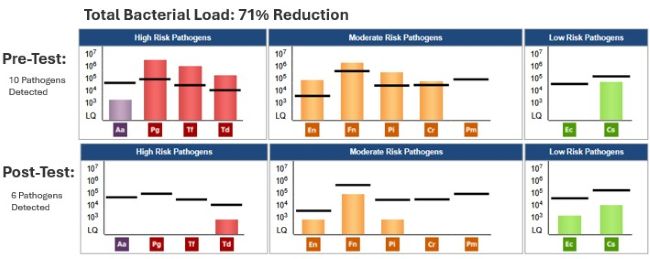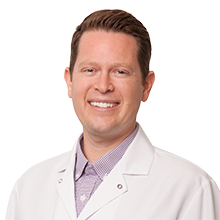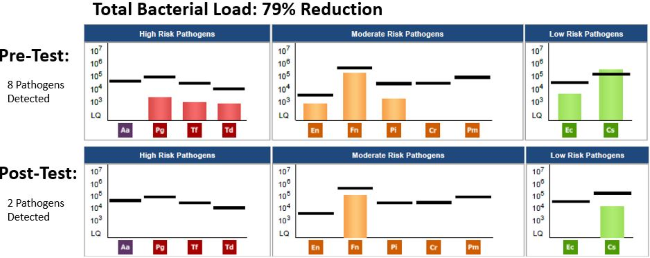Cardiovascular
![Thumbnail [200x250]](img/case-study/kayla_rauschert/rauschert_main.jpeg)
Dental Hygiene Student Discovers the Value of OralDNA<sup>®</sup> Testing
The Challenge:
To reduce periodontal pathogens in the oral cavity that are contributing to severe periodontal inflammation, improve oral malodor as reported by the patient and remove unsightly calculus buildup that is harboring oral pathogens.
The Background:
- Age: 24
- Sex: F
- Medical History: Patient is overall healthy, last blood pressure was 128/78. Patient has been diagnosed with bipolar disorder and autism. Patient is currently taking Haloperidol for Bipolar and uses an albuterol inhaler as needed (PRN). Patient also states use of recreational marijuana daily.
- Family History: Patient informed me that her family has a history of heart disease.
- Last Dental Exam: In 2021 to extract #31
- Home Care: Brushing 1x/day and never flossing.
- Chief Complaint: #17 bothers the patient daily because food gets impacted, and it gives off a bad odor. The patient also does not like the way her mandibular anterior teeth look, due to discolored calculus build up around the margins of the teeth.
- Periodontal Assessment: Stage I Grade B based off assessment, generalized at CEJ and localized recession facial sextant 5.
The Solution:
- Date of MyPerioPath® (Pre-Therapy) Test: 10/21/2021
- Periodontal Therapy: Full mouth non-surgical periodontal therapy (NSPT)
The Result:
My patient and I were able to sit down together and have a conversation about her MyPerioPath® results and she was able to understand and see the different high, moderate, and low risk pathogens that were present in her oral cavity. I noticed a shift in my patient’s mindset about her oral health, especially after I was able to show her the lab results and connect the different pathogens that relate to other possible systemic diseases such as cardiovascular disease. After my patient saw and learned this information, it was a big connection for her personally because she noticed that the pathogens in her mouth could possibly also be related to her family’s history of cardiovascular disease. I am grateful for the opportunity that I was able to present my patient with her OralDNA® results, and I am now confident that I can use OralDNA® testing in my tool kit as a future hygienist to help my patients understand the connection between their oral health and overall health.

About the Author:

Kayla graduated from Colorado Northwestern Community College in 2022. She has several accomplishments while in school such as certification in placing Arestin™, experience with diode laser and Vice President of Student American Dental Hygienists’ Association. She is confident the skills she has developed in school will help her connect to her patient on a personal level and will prepare her for variety which is the “Day in a Dental Office.” She is looking for a home to keep her on her toes.
She moved to Colorado from Oregon, but she visits as often as she can. Her passions include working out, snowboarding, mountain biking and bowling.
![Thumbnail [200x250]](img/case-study/shawn_perla/perla_main.jpeg)
Periodontal Disease and Cardiovascular Disease
The Challenge:
A new patient who has neglected dental care for 20 years with a chief complaint of broken teeth and bleeding gums appoints to address his dental concerns.
The Background:
- Age: 70
- Sex: Male
- Last Dental Exam: 20 years ago
- Home Care: Manual brushing twice a day with occasional flossing.
- Chief Complaint: Patient is experiencing broken teeth and gingival bleeding without pain. However, the patient exhibits signs of dental anxiety.
- Clinical Assessment: Several teeth were planned for extraction along with restorative needs.
- Periodontal Assessment: Generalized 4-6 mm pockets with localized 7-9 mm pockets, inflamed and bulbous gingiva with generalized moderate plaque, as well as heavy subgingival and supragingival calculus.
Additional Comments: Due to a high blood pressure reading of 175/101 following the periodontal diagnosis, all treatment was halted, and he was referred for medical consultation
The Solution:
- Date of MyPerioPath® (pre-therapy test): 1/24/2019
- Other Notes: Patient education focused on improved daily home care and the importance of the mouth body connection, specifically the connection between periodontal disease and cardiovascular disease.
- Periodontal therapy: The same day therapy consisted of four quadrants of scaling and root planing, irrigation with chlorhexidine and use of a SIRO diode laser.
- Systemic Antibiotic used: Metronidazole 500 mg for 8-10 days
- Home Care: Instruction included brushing twice daily, flossing nightly, and incorporating interdental brushes and a Waterpik™
- Date of MyPerioProgress® (Post-Therapy) Test: 5/1/2019
Additional Comments: Approximately 1 week following the initial diagnosis and after medical clearance, the patient began periodontal therapy. The blood pressure reading taken prior to the same day full mouth therapy was 142/92.
The Result:
The patient was very compliant with his home care routine and used the systemic antibiotic as prescribed. The second salivary test revealed a 71% reduction in pathogens overall with Aa, Pg and Tf all lowering to undetectable levels. The patient’s tissue health improved, now stippled and there is almost a 100% reduction in bleeding. The periodontal probe measurements all decreased to 2-3 mm with just one localized 5 mm on tooth #31 mesial remaining. The patient’s high blood pressure is now medication controlled. His medical doctor attributed the initial elevated reading to dental anxiety. He has remained consistent with follow up periodontal cleanings and his oral health appears to be stable. It was amazing to see a patient who stayed away from dental care for two decades, because of fear, start to become a routine patient who understood the significance of periodontal disease.

About the Author:

Shawn graduated from San Joaquin Valley College; Rancho Cucamonga, CA and has been practicing dental hygiene since 2008. He is laser certified and emphasizes the importance of the mouth body connection through patient education. He is quoted “As my patient, you can feel confident that your oral health is my primary concern. Through high-quality treatment, we will establish and maintain great oral health. My goal is to make the dental office a fun and friendly place my patients look forward to visiting.” In his spare time, he enjoys photography, reading, nature, and most of all, spending time with his wife and kids.
![Thumbnail [200x250]](img/case-study/30%20Years%20of%20Periodontal%20Maintenance%20with%20Relapse%20and%20Cardiovascular%20Complications_216947739.jpg)
30 Years of Periodontal Maintenance with Relapse and Cardiovascular Complications
The Challenge:
After decades of periodontal stability, the patient presented with a rapid advancement of pocketing and inflammation over a period of only 9 months.
The Background:
- Age: 60
- Sex: Male
- Medical History: Multiple medications for high blood pressure. Calcium channel blocker and angiotensin II receptor blocker and statin for cholesterol management. In 04/2018, patient had cardiac stents placed and was placed on a blood thinner.
- Family History: Immediate family history of cardiovascular disease. A sibling experienced heart attack.
- Last Dental Exam: 12/11/2018
- Home Care: Patient is highly motivated. Waterpik® daily with plaque seeker tip, Sonicare 2x/day
- Chief Complaint: “I feel like I’m starting to get a deep pocket around my implant.”
- Clinical Assessment: Gingiva was generally medium pink with rolled margins and spongy, erythematous papilla. Isolated severe inflammation visible at tissue around implant. Radiographs showed no pathology on implant and stable bone levels. Biofilm was minimal.
- Periodontal Assessment: Over a period of 9 months, the periodontal assessment showed an increase in 4-5mm pocketing from 4% to 18% with an isolated 9mm pocket on implant. Bleeding on probing increased from 2% to 10%. Using the 2017 AAP Periodontal Classification Guidelines, the patient was classified as having Stage III, Grade C generalized chronic periodontitis with isolated Stage IV due to pocketing at implant, rapid disease progression and cardiac risk.
Additional Comments: Patient was being seen on 4 month periodontal maintenance interval for past 10+ years. Scaling and root planing was first completed in 1980’s, with periodontal charting showing stable periodontium and indicating dormancy of disease over multiple decades. The patient’s cardiovascular inflammation was a likely contributor to the rapid shift in periodontitis activity.
The Solution:
- Date of Pre MyPerioPath (pre-therapy test): 9/13/2018
- Periodontal Therapy: 3 hour non-surgical periodontal therapy was performed including thorough scaling and root planing of all quadrants in a single visit. Post-scaling supra & subgingival polishing with glycine powder.
- Systemic Antibiotic Used: Systemic antibiotics were considered, however the one species above the Reference Line was low risk. We decided to move forward with treatment without supplemental antibiotic therapy. Patient was willing to consider antibiotics if pathogen(s) were persistent.
- Home Care: Daily Waterpik at level 8 for 2 minutes with extra time around implant. Sonicare 2x/day.
- Other Notes: Periosciences® AO Gel to use post-therapy with instructions to apply to all gingiva 3x/day until follow-up appointment.
- Date of MyPerioProgress® (post-therapy test): 12/11/2018
The Result:
Clinical results showed a significant decrease in bleeding on probing and we were thrilled to see a reduction in implant pocketing from 9mm to 5mm and no bleeding. Generalized posterior pockets of 4-5mm were persistent at 18%. The MyPerioProgress report showed an overall bacterial load reduction of 79%. Careful monitoring with future MyPerioPath tests is indicated to ensure these pathogens remain at low levels.
This case exemplifies the need for frequent and close monitoring of all patients’ periodontal status. It also highlights the close link between systemic and oral inflammation. This patient’s periodontal condition had been predominantly stable for the past 30 years. As his cardiovascular health became more compromised, we saw a rapid shift in his oral stability, and an aggressive advancement of his periodontitis. Frequent periodontal assessments allowed us to identify and quickly treat this shift in periodontal disease activity. Moving forward, I hope to assess this patient’s host response and genetic inflammatory risk. While we know the patient has an increased risk of cardiovascular disease due to his family history, further genetic inflammatory marker testing with OralDNA®’s Celsus One™ would give us a more holistic picture of this patient’s true inflammatory risk.

About the Author:

As Director of Dental Hygiene, Kendra Linders, RDH works with patients individually to improve and maintain their oral health. Her goal is to support patients in achieving lifelong, whole-body wellness. She is passionate about education, and believes in developing a customized care plan that will work for each unique person.
Kendra brings 11 years of dental industry experience to the Seattle General Dentistry team. She holds an Associate of Science in Dental Hygiene from Shoreline College, and a Bachelor of Arts in Management Operations & Personnel Psychology from Washington State University. She is also a graduate of the Bale Doneen Preceptorship Course on the oral-systemic prevention of heart attack and stroke, and attends numerous continuing dental education courses each year.
![Thumbnail [200x250]](img/case-study/Patient%20in%20Dental%20Pain%20Case%20Study_212192915.jpg)
Patient in Dental Pain with Uncontrolled Hypertension
The Challenge:
To address the dental concerns to resolve patient’s dental pain. To educate the patient on the connection between dental health and overall health.
The Background:
- Age: 37
- Sex: M
- Medical History: Hypothyroid, hypertension, high cholesterol, snoring and trouble breathing while sleeping
- Family History: Hypertension
- Last Dental Exam: 1/29/2018
- Home Care: Poor, patient tends to seek dental care for emergencies only
- Chief Complaint: Pain
- Other Notes: Referred patient to a cardiologist due to uncontrolled hypertension and referred for screening for possible obstructive sleep apnea
- Clinical Assessment: Multiple teeth with gross decay that require treatment
- Periodontal Assessment: Generalized moderate chronic periodontitis
- Medical Assessment: Patient is obese, has uncontrolled hypertension, should be screened for diabetes, and possible obstructive sleep apnea
The Solution:
- Medical Referral to address hypertension and possible sleep complication
- Date of Pre MyPerioPath® (pre-therapy test): 1/29/2018
- Periodontal Therapy: Scaling and root planing with laser decontamination and irrigation
- Systemic Antibiotic Use: Amoxicillin and Metronidazole for 10 days each
- Education: Discussed Mouth-Body Connection™ with hypertension, diabetes, cholesterol, and overall not feeling well
- Home Care: Sonicare toothbrush and soft picks
- Other Notes: Patient has improved home care and has not missed a follow up visit
- Date of MyPerioProgress® (post-therapy test): 5/09/2018

The Result:
“Improved but not quite there yet.” At his first appointment, the blood pressure reading was 156/105 and he had generalized moderate to severe inflammation with spongy, unhealthy gingiva. Now, at the last periodontal maintenance, the blood pressure reading was 119/82. He still has generalized moderate inflammation, but the improvement in heart health is encouraging. He has had some pocket depth decreases as well. The patient is now going to see our periodontist for additional evaluation. We are insisting a medical evaluation and to continue periodontal care as well as treatment for sleep apnea here. We are not all the way there, but the patient has improved in coming in for regular recalls and his oral hygiene is improving. We will continue to help the patient get the care he needs in order to help him to be happier and healthier overall!

About the Author:
